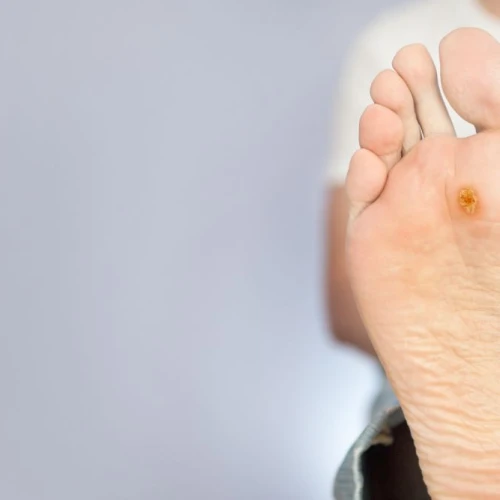Warts are common skin lesions whose appearance will differ based on where they are located. These abnormal skin growths are linked to the presence of a papillomavirus on the surface of the skin.
How can you tell if you have a wart?1
A skin wart is easy to identify. Its features include a raised and well-defined lesion often located on the hands (common wart) or feet (plantar wart) that is rough to the touch. Most people who are affected self-diagnose the wart.
Do you always have to treat a wart?2, 3, 4
Skin warts can heal spontaneously in a few months, but some may persist for several years. In the vast majority of cases, warts will disappear within two years. However, they can also be removed quickly using over-the-counter products available from the chemist. You can use wart-removal products that are applied directly on to the wart, unless it is located on the face, genitals or an area of damaged skin. To remove a wart, you can also use an occlusive dressing. This type of dressing is air and water-tight, which prevents the skin from breathing and, therefore, removes the wart. The dressing should be used for several weeks, until the wart has disappeared. When used with wart-removal products, the occlusive dressing increases the penetration of these products into the skin. Occlusive dressings cannot be used on the face or close to nails.
If the self-medication products do not work, patients should consult their general practitioner or a dermatologist. There are more powerful wart-removal treatments.
However, it’s important to remember that no treatment is currently available to eradicate the viruses responsible for warts, which explains the frequent recurrences.
A dead wart: what are the signs?1, 5, 6
The time it takes for a wart to die will depend on the type of treatment used.
A wart is considered to be dying or dead when its size starts to decrease or, quite simply, it has disappeared. However, other visual and tactile signs can indicate that the wart has died:
- Its colour gradually changes from flesh-coloured to black or dark brown;
- It turns white, if it has been treated with liquid nitrogen or a salicylic-acid solution. It becomes harder and rougher;
- It is covered with blackish pinpoints, which are actually coagulated blood vessels. As the wart heals, these will disappear.
- The wart finally detaches itself from the surrounding skin and drops off.
It should be noted that there is a 30% risk of recurrence due to the persistence of the virus in the skin, even after the lesions have disappeared.


